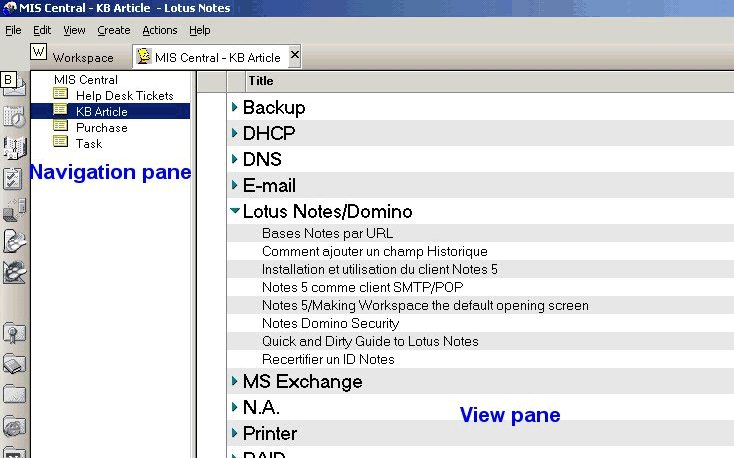Developing for Domino/Notes
Development under Domino/Notes is available through the following tools: @commands, LotusScript (an object-based Basic), JavaScript.The basis of Domino/Notes is a form. It contains differents types of objects (eg. text box, combo box, sub-form, sections, layouts, pictures, etc.)
The second most important element of a database is a view: It lists available documents, and each document will be displayed through a form.
On the left side is the navigation pane, where are listed views.

Elements
Create...
- Field: Text, Date/Time, Number, Dialog List, Checkbox, Radio button, Listbox, Combobox, Rich Text, Authors, Names, Readers, Password, Formula
- Layout Region : New Layout Region, Text, Graphic, Graphic Button
- Insert Shared Field
- Insert subform
- Insert Shared Action
- Action: An action is a toolbar located in a form. It can contain either standard Notes actions (
- Page Break
- Horizontal Rule
- Section : Standard, Controlled Access
- Computed Text
- Hotspot: Link Hotspot, Text Pop-up, Button, Formula Pop-up, Action Hotspot
- Table
- Picture
- Image Resource
- Attachment
- Object
- Java Applet
- Embedded Element: Outline, View, Navigator, Import Navigator, Date Picker, Group Scheduler, Folder Pane, File Upload Control
- Design: Agent, Folder, Form, FrameSet, Navigator, Outline, Page, Script Library, Shared Field, Subform, View
Actions
Click on an empty area of a form, and select Create Action. Name this new toolbar. In the Objects tree, select this new object's Click action, followed by Run Simple Actions in the code window. To select a standard Notes aciton, click on Add Action..., such as Modify Field.Q&A
What are shared actions?
What's the difference between a form and a page?
Development
Below are notes I took while reading Deborah Lynd & Steven Kern's Lotus Notes and Domino 5 Development Unleashed.In forms, organize field through tables so that the layout remains the same whether viewed through a Notes client or a web browser.
Use shared objects sparingly as this drives down performance.
In R5, there is no way to limit the maximum size a DB can have.
To set who can create DBs on a server, open the PNAB | Server document | Restriction document.
Development under Domino can be done with the formula language (ie. @commands), a OO Basic proprietary language called LotusScript, JavaScript, Java, and HTML.
It is recommended to add a synonym to a form in case its public name is changed later: To do this, just add a | sign followed by the synonym.
Forms can be cascaded through the \ sign, eg. HW Requisition\PC, HW Requisition\Laptop.
Versioning can be done through Form Properties | Versions = ...
Avoid setting "Store Forms in Document" in a form's properties as it increases the amount of disk space for the DB.
Fields as well as forms have an internal sequence number that the Replicator uses to detect a conflict.
Form inheritance can be activated through the Form Properties | Defaults Tab | On Create = Formulas inherit values from select document
When using @DbLookup/@DbColumn to populate a list from an external view, consider making it hidden since it has no value to users.
Resources
- OpenNTF ("OpenNTF is a site devoted to getting groups of individuals all over the world to collaborate on Lotus Notes/Domino applications and release them as open source to the general public")